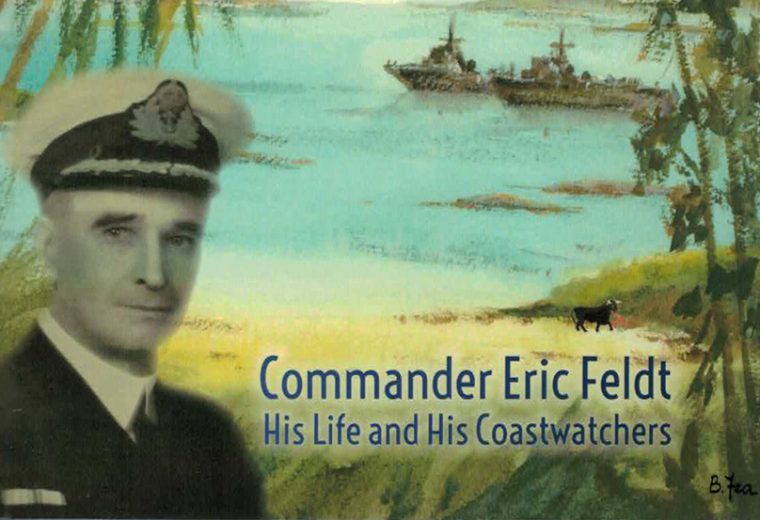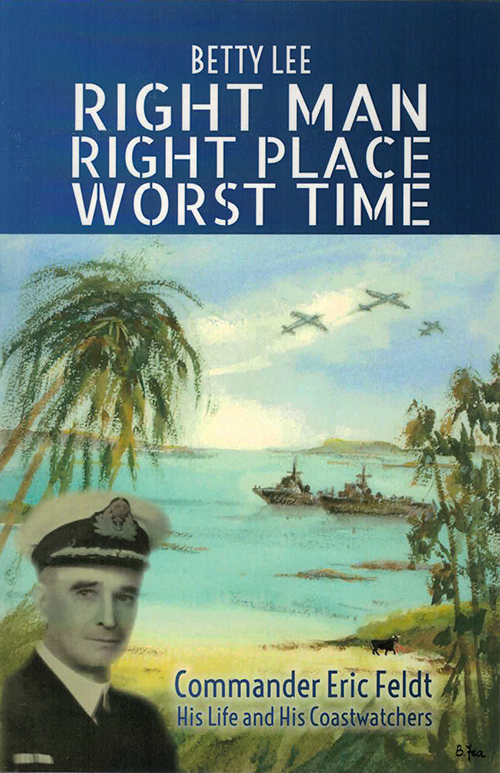Book Review


Right Man Right Place Worst Time
Commander Eric Feldt – His Life And His Coastwatchers
by Betty Lee
Boolarong Press, Tingalpa, QLD, 2019,
318pp.
ISBN: 9781925877267
RRP $33 (Soft Cover)
 This is a comprehensive account of the family and life of one of Australia’s insufficiently known heroes of the Pacific War The story of Eric Augustas Feldt justifies Dr Lee’s evocative title. Feldt’s diverse experiences qualified him superbly for the challenge of setting up and maintaining a coast watch service in the critical period of the Pacific War.
This is a comprehensive account of the family and life of one of Australia’s insufficiently known heroes of the Pacific War The story of Eric Augustas Feldt justifies Dr Lee’s evocative title. Feldt’s diverse experiences qualified him superbly for the challenge of setting up and maintaining a coast watch service in the critical period of the Pacific War.
I had the same portent of destiny when reading the stories of Rod Macqueen and Jessica Watson. Doubtless, Macqueen coaching the Australian Wallabies to victory in the 1999 Rugby World Cup, and Watson sailing singlehanded around the world at age 16 involved different skills and environments. But each needed to draw on all their previous experiences to achieve success. As did Feldt.
The Author is a retired medical practitioner and Great Niece of her subject. She is well qualified to make observations about the effects of health on human performance under pressure, and vice versa. The tragic early loss of Naval College classmates from accidents and illness, affected Feldt who suffered indifferent health for most of his life.
Lee’s account makes clear why Feldt was the Right Man when required to step up. He was able to work productively with each Australian Service, government officials, civilian expatriates, locals and US forces. He used his invaluable contacts with his former RANC classmates and could draw on his skills in small boat handling at crucial times. The author chronicles Feldt’s useful life after WW2, completing the story of a great Australian. I feel this volume comparable to the classic by Albert Facey ‘A Fortunate Life’. Both men endured the same critical events in Australia’s journey.
Feldt was a remarkable man who made his own choices. His family story provides compelling accounts of late 19th century life in tropical Queensland, the involvement of labour from the Pacific Islands in the canefields (blackbirding), the sequel to its abolition (land grants and sugar cane farms too small), the excitement of Federation in 1901, the first Officer Cadet Class of the new Royal Australian Naval College , the life of young Midshipmen in Australian and British vessels in the Great War, and the relatively quiet nature the Royal Navy’s activity during its latter part . Feldt left the RAN after WW1, tried a trading venture between Norfolk Island and Australia, and joined the administration of Australia’s protectorate in New Guinea. Lee covers well the ways Feldt confronted the multiple and varied challenges facing Australian administrators in New Guinea between the wars, the lead-up to and outbreak of WW2 and creation and work of the Coastwatchers. Some 37 died on operations from the 398 Caucasians and a similar number of local natives. Skilled Coastwatchers in charge of outposts numbered 90.
The Coastwatchers gave warning of Japanese naval movements and most importantly of offensive air activity. The warnings allowed the successful defence of Guadalcanal and elsewhere. This highlights the tragedy of the failure of the US Radar station on north Oahu to provide warning of the Japanese air attack on Pearl Harbour. How might history have been changed had US forces been given even a few minutes’ notice that Sunday morning? Reg Evans, an Australian Coastwatcher arranged the rescue of future US President John F Kennedy and the surviving crew of his PT109. This rescue was featured in a broadcast by Richard Glover on ABC Radio on 27 May 2020 in relation to a Podcast series by Michael Adams on ‘Forgotten Australians’.
US Historian Walter Lord ( ‘Lonely Vigil – Coastwatchers of the Solomons’, 1972, p293) says that they were invaluable in warning of enemy activity, rescuing downed airmen and stranded sailors and helping plan the advance of the allies in the Solomons. Their only common but essential requirement was to know the South Pacific and ‘the intricate relationships and loyalties that governed life ii the islands’. Senior US Naval officers were fulsome in their praise of Feldt and his team.
The timing of Feldt’s book ‘The Coast Watchers’ in 1946, no doubt helped ensure official historians had a credible and comprehensive record of a small force that could easily have been then overlooked. Feldt is a master of detail as well as the big picture. The Coastwachers are featured in the official Australian Navy, Army and Air Force histories of the Pacific War – partly because all three services provided members – and in the serious studies of Australian military history.
For example, Jeffrey Grey (‘A Military History of Australia’, 1999, p161) refers to ‘the dedicated and clandestine organisation of Coastwatchers …. set up by Naval Intelligence in the 1920s and which drew upon planters, missionaries and patrol officers.’ The entry on Coastwatchers in the ‘Oxford Companion to Australian Military History’ (1995, p154) is attributed to Feldt’s tome. His book (p397) discloses a personal link. Lt Rolf C Cambridge who coast-watched in New Guinea and Bougainville, is the father of a school colleague and grandfather of my son-in law.
Dr Lee draws comprehensively on Feldt ‘s book but that is focussed on contemporary events and contains nothing of his life before WW2. So, her contributions are the more worthy. Feldt was an austere and modest man who acknowledges his wife for nursing him back to health and putting up with him while he wrote. But he does not mention her name nor of any other family. He received the OBE but arguably deserved more. Lee’s call for a memorial in Australia to Coastwatchers is well justified. There is a Memorial Lighthouse at Madang but nothing in this country. Dr Lee could suggest a site – perhaps Townsville and/or Canberra.
There are many photos well captioned, useful maps, Bibliography, Endnotes and a very helpful Index.
The author has produced an invaluable record of a unique life and the environments he was shaped by and helped reshape.
Ken Broadhead

